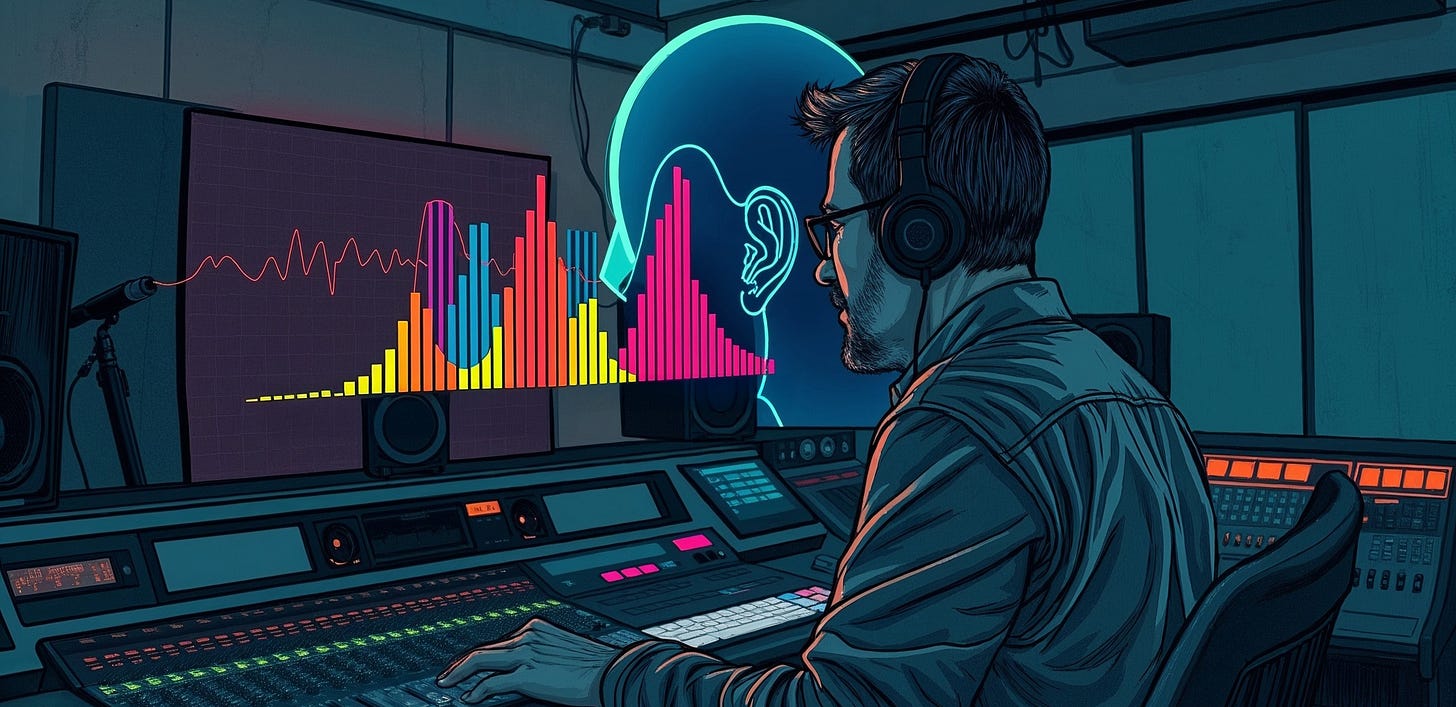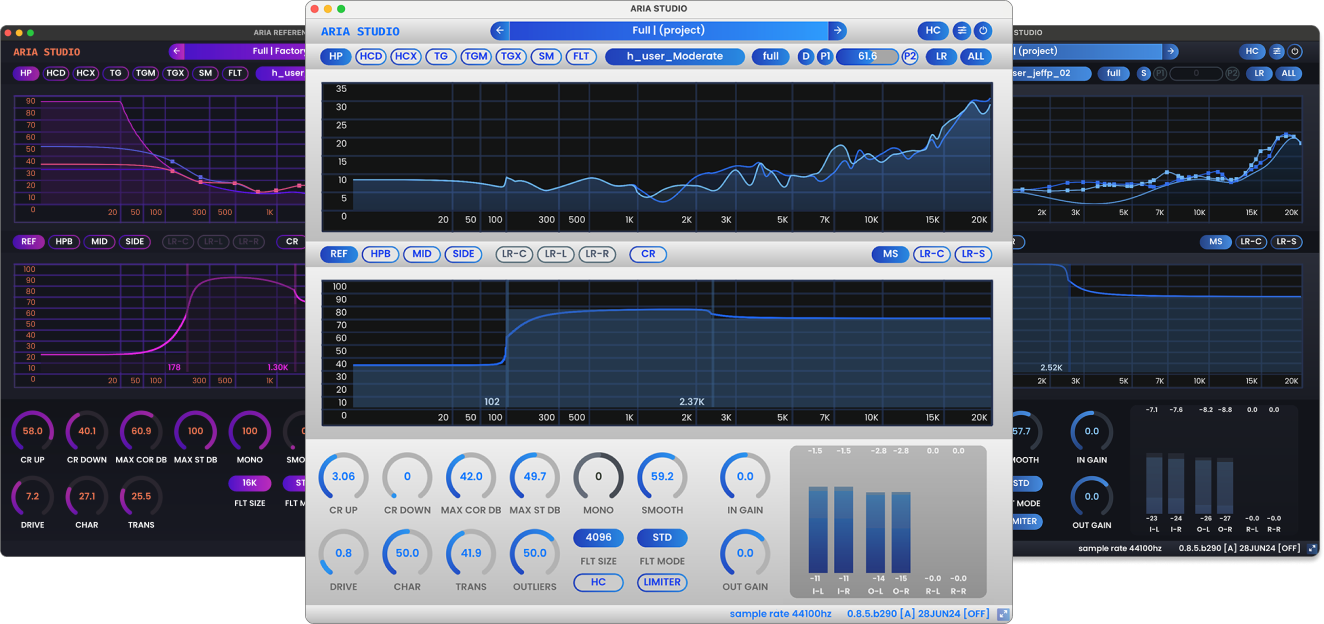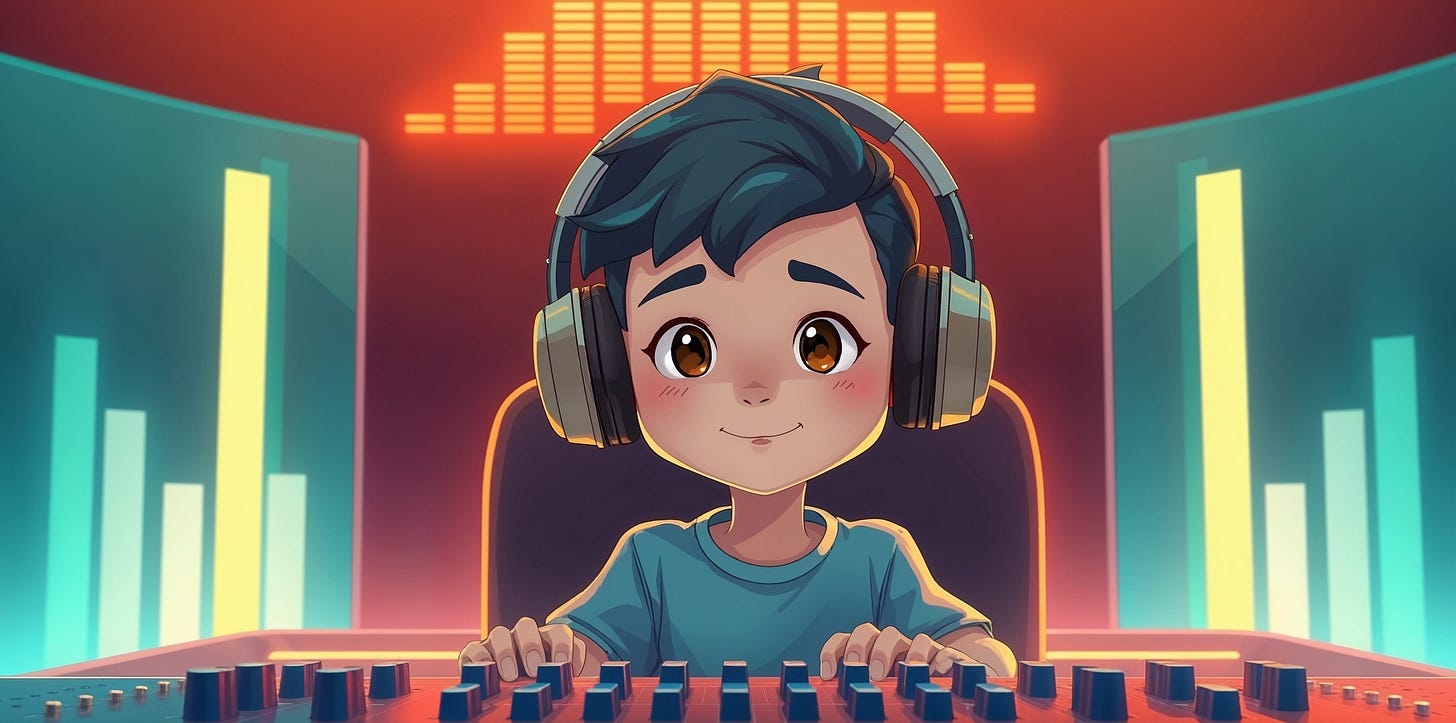Hearing in a New Dimension
How Technology is Reshaping Audio Production for Those with Hearing Loss
The most vital tool for any music producer isn’t found in a rack or software suite—it’s our ears. Yet, for many of us, high-frequency hearing loss from years of exposure to loud sounds or simply the natural aging process creates a silent struggle that affects our work. What happens when a producer’s most essential instrument begins to fail them? Until recently, the options were limited and often inadequate for creative audio work. Today, however, innovative technology is changing this narrative, bringing new possibilities for those who feared their mixing days might be numbered.
The Hidden Challenge in the Studio
Most noise-induced hearing loss begins with a subtle dip in high frequencies, typically around 3-6 kHz—precisely the range crucial for clarity in music. A producer with this common pattern might inadvertently boost certain elements too much, creating mixes that sound harsh to listeners with normal hearing. These translation issues often stem from the mixer’s personal hearing profile affecting their decisions.
For years, the industry response to hearing issues has been largely avoidance and silence. Few professionals openly discussed their hearing challenges, fearing it might cast doubt on their abilities. However, this stigma is gradually lifting as notable figures begin to speak up. Gregory Scott of Kush Audio has candidly discussed mixing with imperfect hearing, encouraging others not to feel shame about it. Even legendary figures like Beatles producer Sir George Martin experienced significant hearing loss in later years, yet continued to produce remarkable work.
The traditional path for addressing hearing loss—visiting an audiologist for a clinical test followed by potentially receiving hearing aids—presents significant limitations for audio professionals. Standard audiologist tests typically focus on a limited frequency range (250 Hz to 8 kHz) designed primarily for speech comprehension. Meanwhile, conventional hearing aids prioritize speech clarity through compression and frequency emphasis that can distort the nuances essential for music production.
New Technologies for the Creative Ear
Recent innovations have emerged specifically for producers and audio creators, focusing not on general environmental hearing but on allowing them to hear their music accurately despite hearing deficiencies. Two particularly promising approaches are transforming how professionals with hearing loss work: software-based hearing correction like Altitude Audio’s FullScale and ARIA Studio, and consumer tech repurposed for hearing assistance, such as Apple’s AirPods Pro 2 in Hearing Aid mode.
Altitude Audio’s FullScale Test and ARIA Studio
The FullScale Hearing Test from Altitude Audio represents a significant advancement over traditional audiograms for music professionals. Unlike clinical tests that typically examine a limited frequency range in octave bands, FullScale maps your hearing across the entire audible spectrum (125 Hz to 20 kHz) with remarkable precision, testing up to 37 discrete frequencies.
This self-administered mobile app test requires calibrated headphones and takes roughly 15-20 minutes to complete. The resulting detailed hearing profile becomes the foundation for ARIA Studio—a standalone application and DAW plugin that acts as a corrective lens for your ears during production.
ARIA Studio works by importing your FullScale hearing profile and applying a corrective EQ tailored precisely to your hearing deficits. If your test showed a 10 dB loss at 6 kHz in your right ear, ARIA will boost exactly that frequency by that amount in the right channel only. The technology employs sophisticated high-resolution FIR filters with up to 16k taps for extremely precise correction, along with dynamics processing, to prevent clipping when boosting weak frequencies.
What makes ARIA particularly innovative is how it integrates with the creative workflow. As a plugin on your master bus or as a system-wide processor, it allows you to mix with your hearing corrected in real-time. You hear what you’ve been missing without having to compensate by cranking volumes or overcooking certain frequency bands. Moreover, it lets you load multiple profiles—you could audition your mix through a client’s hearing profile or a generic profile for an older listener, ensuring your work translates across different hearing abilities.
During my testing of ARIA Studio for my YouTube channel, I experienced firsthand how transformative this technology can be. The software revealed nuances in music that had been previously obscured to me, particularly in the higher frequencies where subtle production details live. This wasn’t just technically impressive—it demonstrated the practical impact these tools can have for audio professionals working with hearing limitations.
Apple AirPods Pro 2: Consumer Tech Meets Hearing Assistance
Apple’s late 2024 update to iOS 18 introduced a feature that blurs the line between consumer audio and assistive technology. With a pair of AirPods Pro 2, users can now perform a built-in hearing test on their iPhone and then activate a Hearing Aid mode on the earbuds, effectively turning them into an FDA-cleared software-based hearing aid.
The process is remarkably straightforward: access the AirPods section in iPhone settings, select “Take a Hearing Test,” and follow the prompts. After measuring your hearing thresholds, you can enable either full Hearing Aid mode (which amplifies ambient sound to compensate for your specific hearing profile) or Media Assist (which applies your hearing compensation only to media playback without necessarily amplifying environmental sounds).
For producers with mild-to-moderate hearing loss, Media Assist offers an intriguing option. Imagine working on a track in your DAW with AirPods Pro 2, having your personal hearing profile applied to everything you’re hearing. The convenience factor is significant—no additional software or hardware required if you already own the earbuds.
The subtle, socially acceptable nature of AirPods also addresses the stigma issue: wearing them throughout a session appears completely normal to observers, yet provides crucial hearing assistance. This invisible benefit has made it easier for me to incorporate hearing help into my workflow without drawing attention to a condition I might otherwise prefer to keep private.
Adapting to Hearing Changes: Perspectives from the Field
What’s particularly encouraging about these technological advances is how they complement the wisdom shared by professionals who have already adapted to hearing loss. Gregory Scott emphasizes that mixing is as much about the brain as the ears—once you understand your hearing profile, you can work around it using multiple cues, including visual analyzers and the feel of the music.
Another legendary case is Beach Boys mastermind Brian Wilson. Deaf in his right ear since childhood, Wilson simply couldn’t perceive stereo width. Rather than let that stop him, he leaned into the constraint and produced Pet Sounds and other classics in mono, insisting every element work through a single speaker.
Legendary guitarist Steve Lukather has spoken about using professional hearing aids specifically tuned for music, with settings that preserve the wide frequency response and natural dynamics crucial for studio work. These accounts demonstrate that hearing issues need not end a creative career; they simply require adaptation.
The community aspect is equally important. As more professionals openly discuss their hearing challenges, collective knowledge grows about effective adaptations. Online forums now host threads where engineers share tips for mixing with hearing loss—from simple tricks like consistently mixing at lower volumes to using reference tracks as a calibration tool.
Practical Steps for Audio Creators
Whether you’re currently experiencing hearing changes or simply want to protect your audio future, several practical approaches emerge from this technological landscape:
First, get to know your hearing. The FullScale test offers a music-specific mapping that can reveal subtle issues a standard audiogram might miss. Even if you believe your hearing is perfect, understanding your baseline helps you track any changes over time.
Second, consider implementing corrective technologies in your workflow. If you’re experiencing high-frequency loss, tools like ARIA Studio can help ensure you’re making mix decisions based on what’s truly in your audio rather than what your impaired hearing perceives. For more casual work or on-the-go production, AirPods Pro 2 with Media Assist might provide sufficient correction, as I’ve found in my own experiments.
Third, adopt protective habits. Monitor at safe levels (around 85 dB SPL for an 8-hour session), use high-fidelity earplugs at concerts or when recording loud sources, and take frequent breaks to allow your auditory system to reset. These practices not only prevent further damage but often lead to better mix decisions—a lesson I wish I’d learned earlier in my career.
Finally, be open with collaborators. Transparency about using hearing correction tools builds trust and normalizes the reality that many of us audio professionals work with some degree of hearing limitation.
The Future of Hearing in Music Production
Looking ahead, we’re likely entering an era where personalized hearing profiles become standard components of the audio production chain. Just as room correction software compensates for acoustic challenges, ear correction technology adjusts for the variations in our hearing apparatus.
These innovations do more than enable continuing careers—they expand accessibility in audio production broadly. Older engineers with a lifetime of wisdom can continue contributing despite age-related hearing changes. Younger producers with congenital hearing issues can enter the field with confidence that their condition can be effectively managed.
As immersive audio formats like Dolby Atmos continue to gain prominence, hearing acuity across the full frequency spectrum becomes even more crucial. Spatial mixes rely on subtle cues that can be missed with even minor hearing deficits. Technologies like ARIA Studio and AirPods Pro’s Hearing Aid feature may prove essential for creating truly translatable immersive experiences.
The tools we’ve explored represent just the beginning of this transformation. As hearing technology advances further, the stigma around hearing loss in creative fields will likely continue to diminish. Perhaps most importantly, these innovations remind us that the core of great production isn’t perfect ears—it’s musical sensitivity, technical knowledge, and creative vision, all of which remain accessible regardless of hearing challenges.
As a technology educator exploring these innovations, I’ve been struck by how they represent more than just technical solutions—they’re changing the conversation about accessibility in creative fields. These tools remind us that technological advancement is most meaningful when it opens doors for people to continue doing what they love, regardless of physical limitations.
To see a detailed demonstration of the FullScale hearing test and ARIA Studio in action, watch my full video tutorial here:
For insights on using AirPods Pro 2 as hearing assistance during production, check out my companion video:




